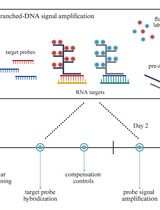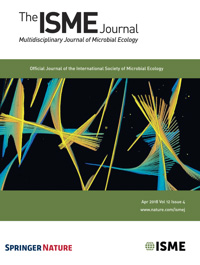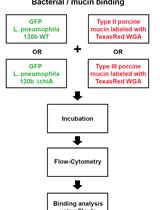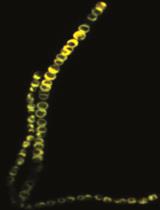- EN - English
- CN - 中文
Detachment Procedure of Bacteria from Atmospheric Particles for Flow-cytometry Counting
从大气颗粒物中分离细菌用于流式细胞计数的步骤
(*contributed equally to this work) 发布: 2019年06月20日第9卷第12期 DOI: 10.21769/BioProtoc.3273 浏览次数: 5518
评审: Alexandros AlexandratosVemika ChandraAnonymous reviewer(s)

相关实验方案

基于Flow-FISH的流式细胞术检测终止型与延伸型HIV-1转录本阳性细胞的定量分析
Shirley Man [...] Neeltje A. Kootstra
2025年07月20日 2083 阅读
Abstract
The protocol separates bacteria from atmospheric particles, obtaining with greater precision their abundance in the atmospheric deposition. This procedure is similar to the one used to separate bacteria in streambed sediments. The detachment procedure consists of a chemical treatment with sodium pyrophosphate and Tween 20 and a physical treatment with agitation and ultrasonic bath to disperse the bacteria in the liquid sample. We recover the total (free and attached) bacteria by generating a density gradient with Nycodenz by centrifugation. The techniques prior to this procedure do not include the microorganisms that are attached to the aerosol particles and, therefore, considerably underestimate the total load and deposition of airborne microorganisms.
Keywords: Airborne bacteria (空气细菌)Background
The study of airborne microorganisms (bioaerosol) is relevant to understand their long-range dispersal and to assess their meteorological consequences (Kellogg and Griffin 2006; Creamean et al., 2013). Airborne microorganisms, aerosolized from soil or sea surface, can be transported large distances by the global atmospheric circulation expanding their distribution ranges (Aller et al., 2005; Hervàs et al., 2009; Yamaguchi et al., 2012). They are removed from the atmosphere by wet (rain/snow) and dry deposition (sedimentation), affecting the microbial abundance, composition, and distribution in recipient ecosystems (Peter et al., 2014; Reche et al., 2018). In addition, bacteria in the atmosphere can act as condensation nuclei of clouds and ice affecting meteorological and climatic conditions (Fröhlich-Nowoisky et al., 2016). Viruses and bacteria usually are air-dispersed attached to soil-dust or to marine organic aggregates, not as free cells or particles (Yamaguchi et al., 2012; Reche et al., 2018). This protocol allows detaching bacteria and viruses from atmospheric particles to quantify them more accurately using flow cytometry (Reche et al., 2018). This protocol can be relevant in the fields of microbial ecology, aerobiology, and atmospheric sciences. This procedure was inspired in another similar by Amalfitano and Fazi (2008) to detach benthic bacteria from stream sediments.
The detachment procedure consists of two steps: first, a chemical treatment by adding sodium pyrophosphate and Tween 20 to break the links to particles and aggregates; and a second physical treatment by shaking and incubation in an ultrasonic bath to disperse the bacteria into the liquid phase. To recover all the bacteria, we generate a density gradient with Nycodenz by centrifugation obtaining four layers (from top to bottom: supernatant, microbial layer, Nycodenz and pellet). We retrieve completely the layer with microorganisms that were suspended in sterilized Milli-Q water up to the original volume, fixed and stored at -80 °C until the flow cytometry analysis.
Materials and Reagents
- Sterile universal pipette tips (Scharlab, S.L., catalog numbers: 000P0210-1 [0.5 μl-10 μl]; 00PC5200-1 [10-100 μl]; 000P1000-1 [100-1,000 μl])
- 1.5 ml microcentrifuge tubes (Labbox Labware S.L., catalog number: PCRP-015-500)
- Flow cytometry tubes (Sarstedt, catalog number: 55.1579)
- Syringe 0.2 μm-filter (Sartorius, MinisartR, catalog number: 16534-k)
- Syringe and needle (ICOplus3, Novico, catalog number: 164624.8)
- Simport Cryovial (SimportTM Scientific, catalog number: T310-5A)
- Bemis Parafilm M (Bemis, catalog number: PM996)
- Polycarbonate membrane filter
- Sodium pyrophosphate tetrabasic (Na4P2O7) (Sigma-Aldrich, catalog number: P8010)
- Tween 20, Polyoxyethylenesorbitan monolaurate (C26H50O10) (Sigma-Aldrich, catalog number: P1379)
- Nycodenz 60% (w/v) (C19H26I3N3O9) (NycoPrepTM Universal, Axis-Shield, catalog number: 31000.01)
- Milli-Q water
- Paraformaldehyde and glutaraldehyde
- Paraformaldehyde (Sigma-Aldrich, catalog number: P6148-500G)
- Glutaraldehyde 25% (Scharlau, catalog number: GL01701000)
- Phosphate-buffered saline tablets (Sigma-Aldrich, catalog number: P4417)
- Sheath fluid (BD FACSFlow, catalog number:342003)
- SYBR Green I (Sigma-Aldrich, catalog number: S9430)
- Dimethyl sulfoxide (DMSO) (C2H5OS) (Sigma-Aldrich, catalog number: 472301)
- Latex 1 μm-beads (Polysciences, catalog number: 18860-1)
- Phosphate-buffered saline (PBS) solution
- Sodium pyrophosphate tetrabasic stock solution (see Recipes)
- Paraformaldehyde and glutaraldehyde solution (see Recipes)
- SYBR Green I solution (see Recipes)
Equipment
- Eppendorf Pipettes (0.5-10 μl, 10-100 μl, 100-1,000 μl)
- Glass beaker
- WiseStir Hotplate stirrer (MSH-20A)
- Vortex mixer for detachment procedure (Velp scientifica, catalog number: F202A0173)
- Ultrasonic cleaner for detachment procedure (P. Selecta, Ultrasons)
- Refrigerated centrifuge (Eppendorf Microcentrifuge, model: 5415R)
- Light source (lamp)
- Ultrasonic cleaner for flow cytometry (Bransonic, model: 200)
- Vortex mixer for flow cytometry (VWR International)
- Flow cytometer (Becton, Dickinson and Company, BC Biosciences, BD FACSCaliburTM)
- Freezer -80 °C (Thermo ScientificTM, HerafreezeTM, model: SAT 901120200, catalog number: HFU686BA)
Software
- BD CellQuestTM Pro Software (Becton Dickinson and Company, https://www.bd.com/en-uk/products/molecular-diagnostics/cytometric-analysis-products)
Procedure
文章信息
版权信息
© 2019 The Authors; exclusive licensee Bio-protocol LLC.
如何引用
Araya, C. M., Cazorla, A. and Reche, I. (2019). Detachment Procedure of Bacteria from Atmospheric Particles for Flow-cytometry Counting. Bio-protocol 9(12): e3273. DOI: 10.21769/BioProtoc.3273.
分类
环境生物学 > 细菌 > 分离
微生物学 > 微生物细胞生物学 > 细胞分离和培养
细胞生物学 > 基于细胞的分析方法 > 流式细胞术
您对这篇实验方法有问题吗?
在此处发布您的问题,我们将邀请本文作者来回答。同时,我们会将您的问题发布到Bio-protocol Exchange,以便寻求社区成员的帮助。
Share
Bluesky
X
Copy link












